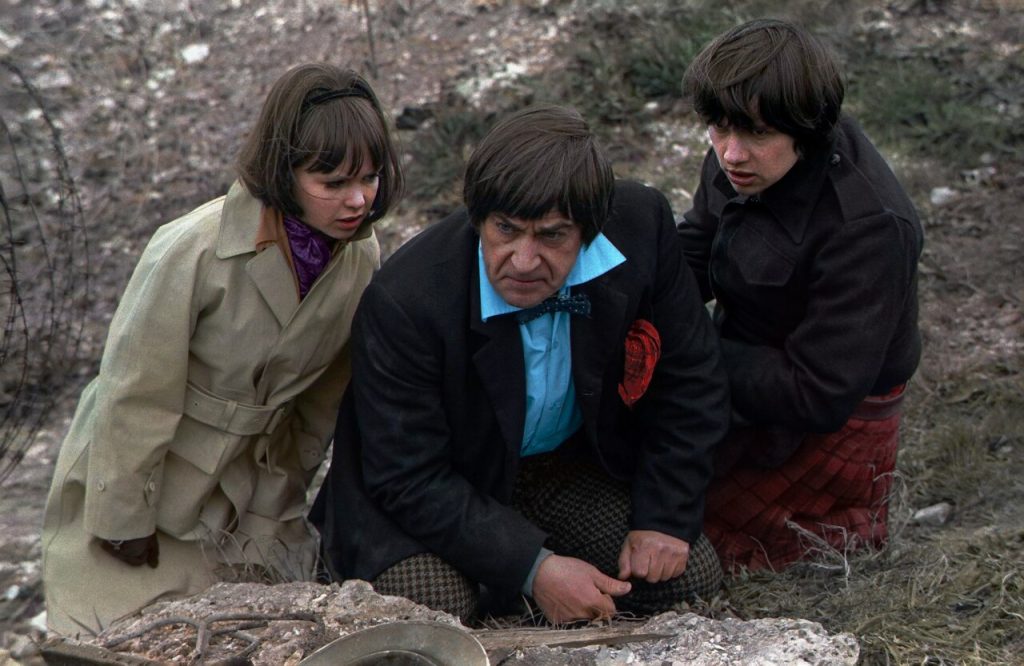Doctor Who has always had a fraught relationship with its own history. What began as a children’s educational program with an edict against “bug-eyed monsters” was quickly catapulted to the top of the ratings by the Daleks. Contemporary adaptations surrounding The War Games portrayed the titular Doctor as a modern-day human who invented a time machine and travelled the universe with his grandchildren. The show remained ambiguous and contradictory in how it addressed the title question (“Doctor who?”) for the first six seasons.
Originally broadcast between April 19th and June 21st, 1969, the ten-part epic The War Games was the most ambitious Doctor Who arc to date. It was the first narrative to form a definitive backstory for the Doctor, and the final serial recorded in black and white. As such, The War Games acted as a turning point in the program’s early history. It introduced Gallifrey, the Doctor’s home planet, and the Timelords, an all-powerful race of isolationist time travellers. The War Games continued the show’s tradition of melding high-concept science fiction with period drama and remains well-regarded among fans. It’s no wonder that the BBC has updated it with The War Games in Colour. There are a host of other changes alongside the colourization, including a fully reworked regeneration sequence, some minor changes to the show’s lore, and a much tighter edit. Clocking in at less than half of the original four- hour runtime, it’s a breezier experience, but inserting contemporary pacing into a decades-old program doesn’t quite work.

Although the original story provides the foundations for the modern show, it’s very much a product of late ‘60s British television. This serial consists of ten episodes, which run for a total of nearly four hours. The bulk of the runtime is made up of monotonous capture and escape sequences, punctuated by a dramatic near-death situation every twenty-five minutes (to ensure viewers would return for the next week). With seasons containing over forty episodes, the show often had to stretch itself thin to fill airtime. The most infamous example of padding is part six of The Daleks, the second serial of season one, which includes a nearly ten- minute sequence of the cast crossing a chasm. By 1969, episodes were being recorded down to the wire (episode one of this serial began filming a week before it aired!). The serialized format was already a throwback to an earlier era of film serials and newspaper strips when the show began in the 60s, never mind that it continued this way until its cancellation in 1989.
Creating a tighter cut by trimming the narrative dead ends and picking up the pace in line with the standards of modern television is a logical aim. Unfortunately, the show was not designed for that. There are dozens of supporting characters (including a Mexican soldier in brownface with a terrible faux-Hispanic accent, another relic of the ‘60s) who only have a scene or two each in this version. They end up feeling like interchangeable sidekicks, with no proper introduction. Though the original was too slow-paced for its own good, this version often moves from plot beat to plot beat with no breathing room. Overall, it’s an odd experiment that can never quite decide what a modern The War Games should look like.
Still, some clever additions in this re-release manage to enhance the story. The colourization opts for vibrant technicolour hues over digital realism, as a sort of what-if to how it might’ve been done at the time. This style is especially effective in the otherworldly production design of the war base, though the war zone sequences looked more convincing and documentary-like in monochrome. The added digital establishing shots are a nice touch. I especially like the war base itself, which is designed to look like the sort of model that would’ve been used in the late ‘60s, though the show didn’t have the time to make it back in the day.

Other additions attempt to tie the show to its modern incarnation, such as the snow globe, Kandor-esque establishing shots of Gallifrey from the Russell T. Davies revival, and Murray Gold’s Master theme playing for the War Chief. The ending sequence, taken from a fan video by The Confession Dial, shows the second Doctor regenerating into the third, something that was never explicitly shown on screen. The yellow glow effects of the regeneration bring it in line with the modern series as well. While largely inoffensive, these additions don’t add anything of note to the story, and clash with the retro aesthetic of the rest of the serial.
More distressing is the CGI closeup of the deceased Jon Pertwee, who portrayed the third Doctor. While the low- budget effects make it especially uncanny, I’ve always found these acts of digital necromancy unsettling; there’s just something inherently dystopian about using the likeness of a dead man for a commercial venture. It is, at the very least, quite brief. The majority of the Pertwee shots are cobbled together from existing footage and composited in, rather than conjured up whole cloth. There are stylish shots of the TARDIS interior as the ship hurtles through the time vortex, but the resurrected Pertwee just feels wrong on a level that’s difficult to fully articulate. While this was less objectionable in a free fan project with no budget and limited resources, an official BBC release has the tools to recast the character or execute the sequence in a more dignified way. The inclusion of CGI Jon Pertwee amplifies the lack of respect this project has for the original show and the people who made it.
Ultimately, The War Games in Colour struggles to find a consistent raison d’être. The story is abridged in a way that makes it difficult for new fans to follow, with many continuity additions targeted more towards hardcore fans. Yet the changes to the lore will inevitably upset certain fans, and the modern additions feel incongruous next to the original footage. As with many of Doctor Who’s attempts to appeal to its core fanbase rather than the broad audience for whom it was originally intended, it’s a confused, insular project with more lore than emotional resonance, not helped by its ghoulish resurrection of a long-dead lead. At least the colours look pretty.
